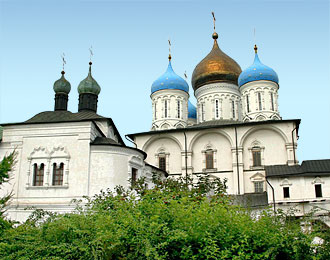 |
 The Novospassky - or New Savior - Monastery lays claim to be the oldest in Moscow, and gets its name from the fact that it was originally located inside the Kremlin in the 14th Century and, possibly, before that occupied the sight of the modern Danilov Monastery. The monastery moved to the new site, on the banks of the Moskva, in 1491 on the orders of Ivan the Great.
The Novospassky - or New Savior - Monastery lays claim to be the oldest in Moscow, and gets its name from the fact that it was originally located inside the Kremlin in the 14th Century and, possibly, before that occupied the sight of the modern Danilov Monastery. The monastery moved to the new site, on the banks of the Moskva, in 1491 on the orders of Ivan the Great.
No structures from that period have survived. The monastery came under the patronage of the Sheremetev and Romanov boyars, and benefited from a complete overhaul when Mikhail Romanov became Tsar in 1612.The bulk of the monastery as it appears today dates from that period, including the mighty fortifications - thick stone walls with seven solid bastions - which took on a more sinister aspect when the site was used as a prison camp in the early years of the Bolshevik government.
The central structure of the monastery, the Cathedral of the Transfiguration of the Savior, dates from 1645, although in style it is most closely related to much earlier buildings such as the Kremlin Cathedral of the Assumption, on which it was partially modeled, as evidenced by its vast arched gables and helmet-shaped domes. The fine frescoes inside are original, and depict in detail the Romanov genealogical claim to the Tsar's throne, juxtaposing it with the descent of the Kings of Israel. Sadly, they are in chronic need of restoration. Annexed to the cathedral are two later structures, the two-tiered Church of the Veil of the Virgin (1675), which housed the monastery's refectory, and the neoclassical Church of the Sign (1795), which was erected by the Sheremetev family as their private tomb.
From the same period as the cathedral are the infirmary Church of St. Nicholas the Miracle Worker and the house of Patriarch Filaret, who was in fact Mikhail Romanov's father, an influential politician forced to take holy orders by Boris Godunov. After Mikhail was elected Tsar by the boyars, Filaret returned to Moscow and ruled in tandem with his son, personally taking responsibility for reforming and improving the taxation system and pressing the claims of the church.
The other prominent building in the monastery is the vast bell tower through which visitors enter. Built between 1759 and 1785 by architect Ivan Zherebtsov, it has a wealth of late baroque ornamentation, and three of its four tiers demonstrate the different types of Greek column: Doric, Ionic and Corinthian.
The small white chapel just north of the bell-tower contains the remains of a former nun of the Ivanovskiy Convent, Sister Inokinya Dosieeya, who is presumed to have been the illegitimate daughter of Empress Elizaveta and Count Razumovskiy. Although she probably spent most of her life in a convent, her identity was adopted by the elusive Princess Tarkanova, heroine of opera and cinema in the 1930's, a Polish imposter who was supposedly seduced by Count Orlov and lured back to Russia, only to be delivered to his mistress, Catherine the Great. The identification of Sister Inokinya as the real daughter would explain her burial here in the Romanov family cemetery.
The monastery was ransacked by Napoleon's troops, and suffered a variety of indignities under the Soviets, of which its penal role was the most abhorrent, but which also included time as an orphanage, a furniture workshop, and a 'rehab' centre for alcoholics. It was turned into a museum in 1968, and eventually returned to the church in 1991. Restoration is on-going, but the monastery remains fairly ragged from rough usage. This, combined with the low number of visitors and relative emptiness of the monastery, gives the place a tranquil charm of its own.
|
 |

 The Novospassky - or New Savior - Monastery lays claim to be the oldest in Moscow, and gets its name from the fact that it was originally located inside the Kremlin in the 14th Century and, possibly, before that occupied the sight of the modern Danilov Monastery. The monastery moved to the new site, on the banks of the Moskva, in 1491 on the orders of Ivan the Great.
The Novospassky - or New Savior - Monastery lays claim to be the oldest in Moscow, and gets its name from the fact that it was originally located inside the Kremlin in the 14th Century and, possibly, before that occupied the sight of the modern Danilov Monastery. The monastery moved to the new site, on the banks of the Moskva, in 1491 on the orders of Ivan the Great.